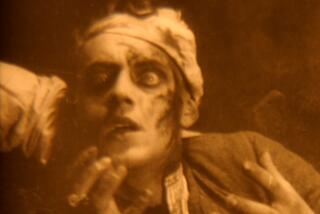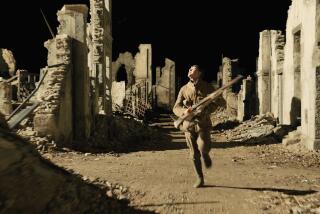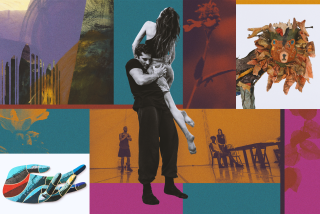The Formidable Harun Farocki
- Share via
No wonder the Goethe Institute has involved Filmforum, CalArts, the UCLA Film and Television Archive and Beyond Baroque in the presentation of a series of film essays by Berlin-based Harun Farocki, surely one of the most challenging, speculative and distinctive filmmakers ever to confront an audience.
As fascinated by technology as by art--and even more by the connections between the two--Farocki seems compelled to observe and probe every aspect of the world around him. No detail, no means of scientific measurement, escapes him as he constantly shifts perspectives: he has a passion for aerial shots and what they reveal about the topography of civilization, yet he will also show you a cat’s eye view of an Oriental rug.
Leaving “Before Your Eyes--Vietnam” (1981) to the last (Saturday at 8 p.m. at CalArts) probably was a wise move, for it is likely the most formidable film in the series, one of those works perhaps no more than a dozen people could hope to comprehend fully, at least on a first viewing. Imagine Godard, Farocki’s hero, intensified to the nth degree, and you’ll have a rough idea of what this film is like. Not documentary, although including considerable archival footage, and not a linear drama either, it’s rather a series of vignettes in which we are bombarded with more information, more images, more ideas than we can possibly hope to absorb. Some things seem clear enough: that Farocki, not surprisingly, is ferociously critical of the war and America’s involvement, yet places the entire catastrophe within a profoundly Olympian Weltanschauung .
Farocki worries about the reductive process in filmmaking: the image not being synonymous with the event it captures, and descriptions of film further removing us from primary experience; the ironic paradox here is that for all its black-and-white beauty, its discreet score and precise subtitles (everyone helpfully speaks economically), “Before Your Eyes--Vietnam” at nearly two hours is so wearying and oppressive that you probably would get more a sense of it from reading a transcript.
Refreshingly, the 75-minute “Images of the World and Inscriptions of War” (1988-89), which screens tonight at 8 at the Filmforum at LACE and Tuesday night at CalArts at 8, is as accessible as “Before Your Eyes--Vietnam” is inaccessible. It’s a consideration of the nature of photography in all its political and moral implications.
Its points of departure are a 1944 aerial photograph of Auschwitz (the Allies could have bombed the railway depositing thousands of victims but had other priorities, Farocki maintains); a photo of an attractive woman, freshly arrived at Auschwitz, startled to realize she’s being photographed (to Farocki the photo represents simultaneous acts of destruction and preservation) and a series of 1960 photos of normally veiled Algerian women, never before photographed and stunned by this unprecedented invasion of privacy ordered by the crumbling French colonial government.
“Images of the World and Inscriptions of War” reveals the dehumanizing effect of the notorious German passion for scientific precision and detachment, and in doing so becomes one of the most coolly effective and comprehensive contemplations of the Holocaust.
On a lighter note, the 83-minute “How to Live in the Federal Republic of Germany” (1988-89), which screens Wednesday at UCLA’s Melnitz Theater at 7:30 p.m., takes a bemused look at German efficiency--the film’s opening image equates sexual intercourse with machinery in operation--in a series of highly organized activities, usually involving instruction. Amusingly, a class on natural childbirth is just as methodical as a stripper being coached on how to disrobe. There’s also a lament for the passing of the artisan as Farocki records the closing of the last metal pressing shop in West Berlin. Information: (310) 854-0993.
More to Read
Only good movies
Get the Indie Focus newsletter, Mark Olsen's weekly guide to the world of cinema.
You may occasionally receive promotional content from the Los Angeles Times.










